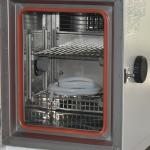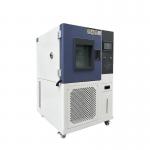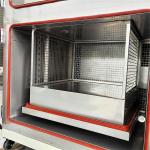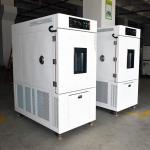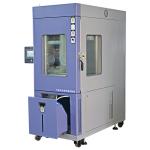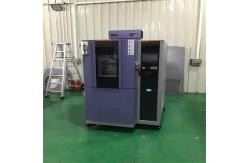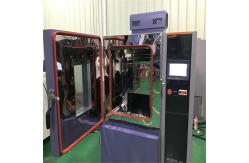In the fast-paced and highly competitive electronics industry, the
reliability and durability of electronic products are
non-negotiable. The Programmable Climatic Chamber with Fast
Temperature Change emerges as a vital tool, specifically tailored
to meet the unique demands of this sector. This advanced climatic chamber is designed to subject electronic
components, devices, and systems to rapid and precisely controlled
temperature changes within a programmable environmental setting. It
serves a wide range of applications in the electronics industry,
from semiconductor manufacturing and circuit board testing to the
evaluation of consumer electronics and telecommunications
equipment. The primary objective is to replicate the diverse and
often extreme temperature conditions that electronics encounter
during their lifecycle, including manufacturing processes,
operation in different climates, and exposure to heat generated
during use. By accurately simulating these thermal environments,
electronics manufacturers and research institutions can identify
potential weaknesses, optimize product designs, and ensure
compliance with industry standards and regulations. - Robust and High-Tech Design
- The chamber is constructed with a heavy-duty framework, typically
made of corrosion-resistant steel, to withstand the rigors of
continuous temperature cycling and the corrosive effects of some
electronic manufacturing environments. The exterior is designed to
be both durable and space-efficient, making it suitable for
integration into electronics laboratory or production line setups.
The interior is lined with a non-reactive and smooth surface, such
as stainless steel or a specialized anti-static material, to
prevent any interaction between the chamber and the sensitive
electronic specimens. The door is engineered for a tight seal,
featuring a reliable locking mechanism and a heavy-duty gasket. It
also includes a viewing window, usually made of tempered glass with
anti-fog and anti-scratch properties, enabling visual monitoring of
the testing process without disturbing the internal temperature and
humidity environment.
- Precision Temperature and Environmental Control Systems
- Temperature Control: The temperature control system is highly
accurate, capable of maintaining a wide temperature range,
typically from -70°C to +150°C, with an accuracy of ±0.3°C. It
utilizes advanced refrigeration and heating technologies, along
with a sophisticated feedback loop and multiple temperature
sensors. This ensures rapid and uniform temperature changes and
stability throughout the chamber. The control panel allows for easy
programming and adjustment of temperature settings, enabling the
creation of complex temperature profiles with precise ramping and
holding periods.
- Humidity Control (Optional): For applications that require humidity
simulation, the chamber can be equipped with a humidity control
system. It can achieve humidity levels from 10% to 98% RH (Relative
Humidity), with an accuracy of ±3% RH. The system employs a
combination of humidifiers and dehumidifiers, along with a
well-designed air circulation system, to maintain stable and
accurate humidity levels.
- Temperature Transition: The key feature of this chamber is its
ability to transition between temperatures at a remarkably fast
rate. The temperature change rate can be as fast as 20°C to 30°C
per minute, allowing for a highly realistic simulation of the rapid
thermal cycling that electronics products experience. The
programmable control panel enables users to define the rate of
change, the duration of each temperature stage, the number of
cycles, and other parameters, providing a highly customizable
testing environment.
- Advanced Instrumentation and Data Acquisition
- The chamber is outfitted with a comprehensive suite of sensors.
Temperature sensors are distributed throughout the chamber to
monitor the temperature at different locations, ensuring that the
samples experience the desired temperature conditions uniformly.
Humidity sensors (if applicable) are also strategically placed to
accurately measure the relative humidity. These sensors are
connected to a state-of-the-art data acquisition system that
records and stores all the temperature and humidity data. The data
can be accessed and analyzed in real-time or retrieved later for
in-depth studies. The data acquisition system is highly flexible
and can be integrated with electronics-specific software and
databases, facilitating seamless data transfer and analysis. It can
also be configured to send notifications and reports automatically,
saving time and effort for the users. Additionally, the control
panel includes built-in alarms and safety features that alert users
in case of any abnormal temperature, humidity, power failures, or
equipment malfunctions.
- Volume and Dimensions: The chamber is available in various sizes to accommodate
different electronic product sizes and testing volumes. The volume
can range from a few liters for testing small semiconductor chips
or individual components to several cubic meters for larger
electronic assemblies or multiple samples. The external dimensions
are configured to fit within standard electronics laboratory or
production facility spaces, taking into account factors such as
access, ventilation, and clearance. The interior dimensions are
optimized for proper air circulation and uniform temperature and
humidity distribution, ensuring that all parts of the tested
samples are exposed to the desired environmental conditions.
- Temperature Uniformity: The temperature uniformity within the chamber is maintained
within ±0.5°C during both high and low-temperature conditions. This
ensures that all electronic components within a sample experience a
similar thermal environment, which is crucial for obtaining
accurate and reliable test results.
- Humidity Uniformity (if applicable): When the humidity control system is engaged, the humidity
uniformity is maintained within ±5% RH, guaranteeing that the
samples are exposed to consistent moisture levels throughout the
chamber.
- Temperature and Humidity Stability: Both the temperature and humidity systems (if present) offer
excellent stability, with minimal fluctuations over time. This
allows for consistent and repeatable testing, enabling electronics
manufacturers to compare results accurately and make informed
decisions about product improvements.
- Temperature Change Rate: The chamber can achieve a rapid temperature change rate,
typically ranging from 20°C to 30°C per minute, depending on the
specific settings and the thermal load of the samples. This fast
transition capability is essential for simulating the real-world
scenarios that electronics products face, such as the rapid heating
and cooling that occurs during power cycling or exposure to
different ambient temperatures.
|
